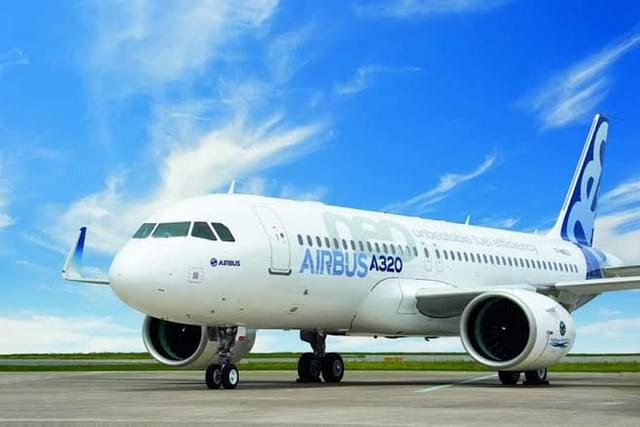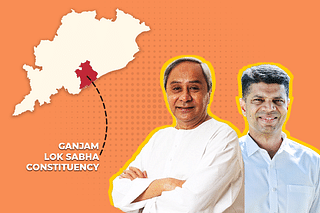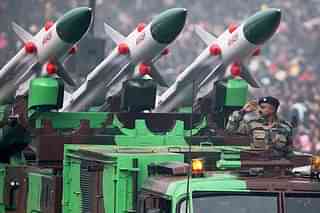Infrastructure
Plane Matters: Airbus And Boeing Have Assembly Lines In China, It’s India’s Turn Now
Manish Pant
Jan 28, 2024, 10:56 AM | Updated Jan 29, 2024, 10:07 AM IST
Save & read from anywhere!
Bookmark stories for easy access on any device or the Swarajya app.

Within hours of an impressive fly-past by the Indian Air Force aircraft to commemorate the country’s 75th Republic Day with French President Emmanuel Macron in attendance, global aircraft major Airbus announced its partnership with the Tata group to set up the Final Assembly Line (FAL) for its bestselling single-engine six-seater H125 helicopters for civilian use on Friday (26 January).
The development has led many to ask when will India, as the world’s fastest-growing civil aviation market, likely see its first assembly for civilian planes by aircraft majors Airbus and Boeing, which already have a significant presence in the country.
That’s logical, as given the anticipated growth in the country’s air travel market the time for such facilities may well be around the corner.
Terming this growth nothing short of ‘revolutionary’, Remi Maillard, president and managing director of Airbus India and South Asia, said during the recently concluded Asia’s largest airshow WINGS 2024 in Hyderabad, “With the record aircraft deliveries to India and with the exponential growth in infrastructure development, airports, Maintenance, Repair and Overhaul (MRO), training centres, leasing industry, global aviation is pivoting to India and we are only seeing the tip of the iceberg. The economic fundamentals are strong.”
In the 2023 calendar year, nearly 153 million people travelled by domestic carriers. This is projected to nearly double to 300 million by the decade’s end.
Commensurate with this growth, the civilian aircraft fleet is also seen to be expanding from the current 713 to 2,000 — an almost 95 per cent increase — in the next decade, according to the Ministry of Civil Aviation data. For this part, Maillard feels the country will require an additional 2,500 aircraft by 2042.
Meanwhile, Jyotiraditya Scindia, Union Minister of Civil Aviation, has been busy highlighting India’s rapidly expanding market opportunity and large talent pool to position it as ‘the new promised land for aerospace manufacturing’.
Urging the world to take advantage of this opportunity to set up a FAL here, Scindia reiterated at the Hyderabad airshow that while “some (aircraft manufacturers) had a top-down approach, others have a bottom-up approach, where you bring ancillary players up to speed so that they begin producing aircraft parts and grow from there.”
He has a point: Over the years, the Big Two of aircraft manufacturing have gone about setting up a robust supplier ecosystem comprising several micro, small and medium enterprises in the country.
While Airbus now sources various components from 100-plus Indian companies, Boeing has more than 300 such vendors to position itself as the largest aviation Original Equipment Manufacturer (OEM) in the country.
“We have engineering here, we have IT here, we have large-scale manufacturing and then we have significant research and development capabilities as well. For us, India is a unique place because it’s going to be one of the largest aviation markets in the world for the entirety of this century!” observes Salil Gupte, President of Boeing India.
Currently, Boeing exports $1 billion worth of assemblies and Airbus $850 million worth of aircraft sub-assemblies from India.
Making In India
To promote atmanirbharta (self-reliance) in the field of aircraft manufacturing for both aerospace and defence sectors, an Airbus C-295 tactical transport aircraft manufacturing facility is being established in Gujarat with the first Made-in-India aircraft expected from September 2026.
In 2021, Boeing announced the addition of a new production line under the Tata Boeing Aerospace Ltd (TBAL) joint venture to manufacture complex structures for its flagship 737 series. Most recently, Prime Minister Narendra Modi inaugurated Boeing’s Rs 160 billion state-of-the-art engineering and technology centre in Bengaluru, the company’s second-largest globally.
The world’s second-largest aerospace OEM Safran, has also invested in multiple ventures in India including setting up an electrical harness manufacturing facility in Hyderabad and another one to produce components for use in the new generation of LEAP aircraft engines.
It is also producing components for CM56 and LEAP engines for CFM International in a JV with the state-owned Hindustan Aeronautics Ltd (HAL) in Bengaluru.
The company has also announced an investment of $150 million for the manufacture of aircraft engines in India at Hyderabad. Airbus is also setting up separate maintenance and pilot training centres to support the programme.
While both Airbus and Boeing have had FALs in China for the manufacture of their flagship A320 and B737 series, respectively, the desire to offset geopolitical, supply chain and logistics risks, as well as the pursuit of China Plus One strategy, may finally lead them to favourably look at India as well.
Besides, there are concerns about copyright infringement when companies manufacture in China. For instance, the country has been accused of reverse engineering designs from Airbus and Boeing while developing its own Comac 919 jet to challenge the duopoly.
“In the coming decades, an efficient supply chain would be the norm. With India having proven itself in delivering on hi-tech engineering, we should see significant growth in ancillary industries supporting both civil and defence supplies,” points out Jagannarayan Padmanabhan, Senior Director at the advisory CRISIL Market Intelligence.
Jaideep Mirchandani, Group Chairman of aviation solutions provider Sky One agrees with Padmanabhan’s assessment: “Investing in local manufacturing positions us strategically for the industry's dynamic evolution as India possesses the manpower, infrastructure and technology to foster this setup. It aligns with the expanding fleet needs of Indian airlines and contributes significantly to the Government’s Make-in-India initiative.”
First Things First!
Others like Arun Kumar Singh, aviation commentator and former CEO of regional carrier IndiaOne Air, feel the discussion around setting up an FAL at this stage might be premature as the mere presence of aircraft manufacturing may not necessarily translate into a growth in air travel.
“Please understand that the absence of aircraft manufacturing is not the root cause, but a mere symptom of policy paralysis, lack of infrastructure development, non-incubation of the talent pool and archaic tax regulations. Talking about manufacturing aircraft is getting ahead of ourselves,” emphasises Singh, adding, “Unless we address these points, we will be addressing the problem on a reactive basis.”
He says that several countries that have a buoyant air travel market have gotten there by rolling out policies promoting air travel rather than setting up manufacturing facilities.
However, Boeing’s Gupte feels that the country’s traditional strengths have the potential to be taken to the next level.
“Bringing together engineering and manufacturing means that India can go beyond simple assemblies to complex assemblies, to working with complex materials like composites, to increasingly getting into more and more parts of the aircraft.”
And given this possibility an aircraft assembly may not be a pipe dream any longer.
Save & read from anywhere!
Bookmark stories for easy access on any device or the Swarajya app.
Support Swarajya's 50 Ground Reports Project & Sponsor A Story
Every general election Swarajya does a 50 ground reports project.
Aimed only at serious readers and those who appreciate the nuances of political undercurrents, the project provides a sense of India's electoral landscape. As you know, these reports are produced after considerable investment of travel, time and effort on the ground.
This time too we've kicked off the project in style and have covered over 30 constituencies already. If you're someone who appreciates such work and have enjoyed our coverage please consider sponsoring a ground report for just Rs 2999 to Rs 19,999 - it goes a long way in helping us produce more quality reportage.
You can also back this project by becoming a subscriber for as little as Rs 999 - so do click on this links and choose a plan that suits you and back us.
Click below to contribute.





